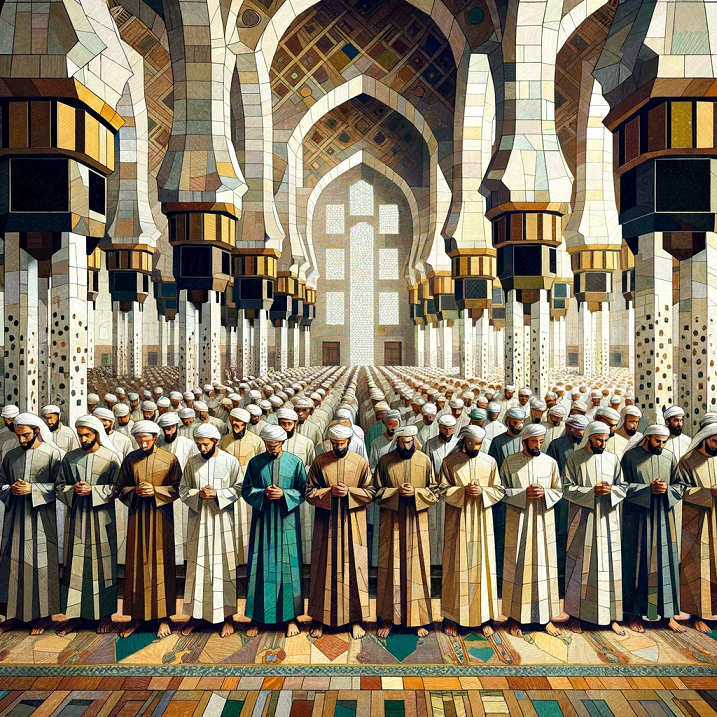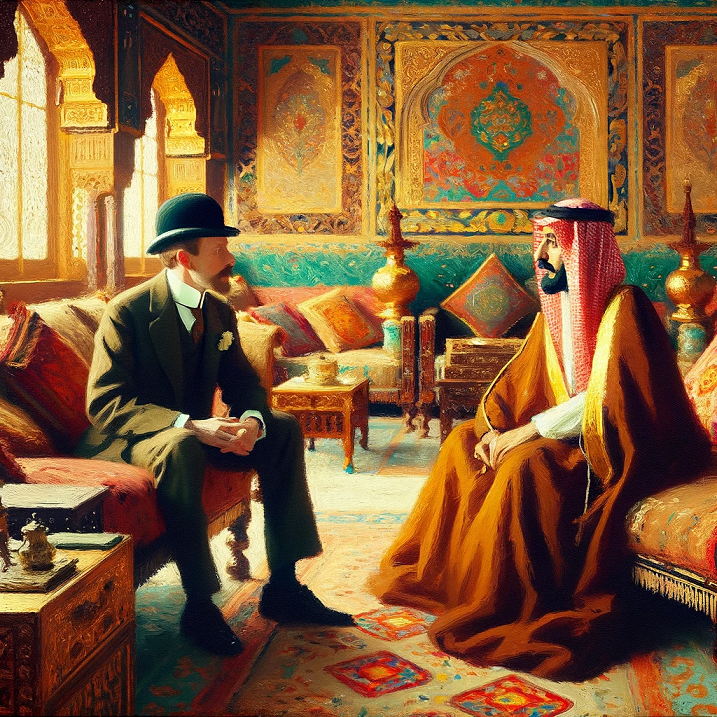In the early 20th century, Harry St. John Philby, an esteemed British explorer and writer, journeyed through the heart of Saudi Arabia, encapsulating his experiences in the seminal work “Arabia.” Philby’s narrative, rich with details of his time in Riyadh and other significant regions, offers a window into the cultural and religious tapestry of the land. His observations during the Islamic month of Ramdhan in 1918, particularly in the context of the Wahhabi movement and its practices, provide a vivid portrayal of life in Saudi Arabia during this era. Central figures like Ibn Sa’ud play a pivotal role in his account, illustrating the intricate interplay between leadership, faith, and daily life amongst the Saudi people and tribes.
Key Takeaways
- Philby’s journey in 1918 highlights the cultural richness of Saudi Arabia.
- The Wahhabi practices during Ramdhan demonstrate a deep religious commitment.
- Ibn Sa’ud’s leadership is characterized by curiosity and adaptability.
- Ramdhan in Riyadh is a time of intense spiritual observance and community bonding.
- The Night of Glory holds immense importance in Wahhabi religious practices.
- Philby’s experiences provide a unique insight into early 20th-century Arabia.
Riyadh Ramadhan Observance
On June 24, 1918, Philby entered the bustling capital of Riyadh, coinciding with the 15th day of the holy month of Ramdhan. The new moon, which guides the Islamic holy months, had been sighted in the region of Qasim, setting the stage for the commencement of Ramdhan’s rigorous observances. The Wahhabi capital, under the guidance of its religious authorities, had aligned its calendar accordingly, marking a period of deep religious significance and personal trial.
In Riyadh, the exhaustion among the populace was palpable as they were halfway through the demanding month of Ramdhan. The fast, observed from dawn till dusk, presents a profound challenge, especially during the hotter months. Philby notes that in Arabia, the “sting of Ramdhan is in its tail,” signifying the increasing hardship as the month progresses. This particular Ramdhan was unique, falling around Midsummer’s day, a rare occurrence that added to the rigour of the fasting period. The faithful, including Philby, observed this period with a mix of reverence and endurance, highlighting the deep religious commitment of the Wahhabi followers.
Historical and Religious Context
Philby delves into the historical and religious significance of Ramdhan, noting its origins from a time when the month coincided with the winter season. The Prophet Muhammad, perhaps unaware of the lunar calendar’s inherent inconsistencies, had chosen this period for the first Ramdhan. This choice, made in the context of Arabia’s climate and day length, did not account for the vast differences in daylight hours experienced in other parts of the world.
A poignant conversation between Philby and Ibn Sa’ud sheds light on the adaptability of Islamic practices in varying geographical contexts. When questioned about the practicability of observing Ramdhan near the North Pole, where the sun barely sets during summer, Ibn Sa’ud, knowledgeable in matters of faith, suggested that a true Muslim would adapt by fasting twelve hours a day, treating the rest as night. This interpretation, while not strictly in line with Quranic precepts, demonstrates an attempt to reconcile religious practice with the physical realities of different geographies.
Once, when Ahmad IbnThunaian was present, he asked me what was the language of the Americans ; I told him that their speech was English. ‘ What, then,’ he asked, ‘ are they of English stock ? I thought they were of Indian origin.’ I explained about the Red Indians and the term ‘ West Indies ’ in reply and asked if America was mentioned in the Quran, ‘ Yes,’ said Ahmad without hesitation ; Ibn Sa’ud came to his rescue when I hazarded the suggestion that the New World had not been discovered in the time of Muhammad.
St. John Philby: Arabia
Ibn Sa’ud’s Curiosities and Discussions
In his narrative, Philby portrays Ibn Sa’ud as a figure of great curiosity and intellectual engagement, often initiating discussions that spanned various global topics. These conversations ranged from the status of Indian princes to the nuances of the relationship between Afghanistan and Britain, and even to America’s origins and language. Ibn Sa’ud’s inquiry about whether America was mentioned in the Quran led to a broader discussion about the extent of divine knowledge and its representation in religious texts.
Once, when Ahmad IbnThunaian was present, he asked me what was the language of the Americans ; I told him that their speech was English. ‘ What, then,’ he asked, ‘ are they of English stock ? I thought they were of Indian origin.’ I explained about the Red Indians and the term ‘ West Indies ’ in reply and asked if America was mentioned in the Quran, ‘ Yes,’ said Ahmad without hesitation ; Ibn Sa’ud came to his rescue when I hazarded the suggestion that the New World had not been discovered in the time of Muhammad.
St. John Philby: Arabia
This intellectual exchange extended to geographical concepts, with Philby explaining the “orbicularity” of the earth to Ibn Sa’ud, who was initially perplexed by the idea of reaching America by travelling either westward or eastward. This discussion underscores the merging of scientific understanding with religious and cultural knowledge, a characteristic of the era’s intellectual climate.
‘ Do you know,’ I asked, ‘ that you can reach America both by travelling westward and travelling eastward ? ’ Ibn Sa’ud was puzzled, but Ahmad reminded him of the ‘ kurriyat ’ or ‘ orbicularity ’ of the earth, though even that failed to satisfy him of my complete sanity, when I assured him that by travelling eastward or westward round the world he would come again to his starting-point without tracing his steps.
St. John Philby: Arabia
Philby’s recollection of these dialogues not only sheds light on Ibn Sa’ud’s inquisitive nature but also highlights the broader cultural and intellectual milieu of early 20th century Saudi Arabia. It shows a society and its leaders grappling with the integration of traditional beliefs and emerging global knowledge, a theme that resonates throughout Philby’s observations in “Arabia.”
The Significance of Ramdhan in Wahhabi Faith
Philby, in his exploration of the Wahhabi practices during Ramdhan, draws comparisons to other religious observances such as the Christian Lent or the Jewish Passover. The month of Ramdhan, a cornerstone of Islamic faith, especially among the Wahhabis, is marked by a stringent adherence to fasting from dawn until dusk. This period is not just a test of physical endurance but also a demonstration of spiritual devotion.
The daily practice during Ramdhan, as observed by Philby, involves abstaining from food, drink, and marital relations during daylight hours.Philby notes the exceptional commitment of the Wahhabis to their faith, as they not only follow the prescribed fast but also devote significant portions of their day to prayer and contemplation, often reading the Quran extensively.
Ibn Sa’ud, a central figure in Philby’s narrative, embodies the Wahhabi dedication to Ramdhan. Despite his responsibilities as a leader, Ibn Sa’ud balanced his duties with religious observance, engaging in state affairs but also partaking in the rituals of fasting and prayer. This blend of leadership and piety, as witnessed by Philby, is indicative of the deep-rooted religious values within the Wahhabi community.
Observance and Rituals of Ramdhan
In his detailed account of Ramdhan in Riyadh, Philby emphasises the heightened significance of the last ten nights of the month, particularly focusing on the ‘Night of Glory’ or ‘Lailat ul Qadr.’ This night holds immense spiritual importance as it is believed to be when the Almighty frees the greatest number of souls from Hell. The exact date of this night is shrouded in mystery, prompting the faithful to engage in rigorous religious exercises throughout the final ten nights of Ramdhan.

Philby observes that the practice of reading the Quran during this period is not just a ritualistic act but a profound expression of faith. He notes the extraordinary effort of devotees, who would complete the recitation of the Quran up to thirty times in a single month. This intense spiritual commitment is contrasted with Ibn Sa’ud’s more moderate but still remarkable practice, hindered only by his state responsibilities.
The more often the Quran is read through from cover to cover during the month, the greater is the credit in one’s favour in the final reckoning. Devotees like the aged ’Abdulrahman managed to repeat this stupendous performance as many as thirty times in as many days, but Ibn Sa’ud confessed that necessary and unavoidable attendance to affairs of state made it impossible for him to achieve more than four or five such readings during the month.
St. John Philby: Arabia
Personal Interactions and Observations
In his personal interactions and observations, Philby offers a unique perspective on the daily life and practices during Ramdhan in Riyadh. He notes the communal spirit evident in the pre-dawn meals, where people, albeit with little appetite, partake in food and drink in preparation for the day ahead. This communal aspect extends to the evenings, where the breaking of the fast becomes a shared experience, with dates and water followed by servings of sliced melons.
The daily routine during Ramdhan, as witnessed by Philby, is a meticulous blend of prayer, fasting, and statecraft. The pre-dawn meal, known as Suhur, marks the beginning of the fast. The end of the day’s fast is signified by the sunset prayer and the breaking of the fast with dates and water, followed by a modest evening meal. These practices, interwoven with state affairs and religious observances, paint a vivid picture of the discipline and devotion characterising the Wahhabi practice of Ramdhan.
Philby’s narrative further highlights the intimate moments in the lives of the Wahhabi people during this time. The “ritual embargo” on conjugal relations during daylight hours leads to a temporary separation from female companionship, a practice observed with great seriousness. This separation, however, is reconciled each evening, signifying the balanced approach to religious observance and family life.
No food or drink may be touched until the sunset Adhan — period at this time of some 15| hours in the hottest and driest and dustiest season of the year. Under such conditions sleep was the natural refuge of the weaker souls, but Ibn Sa’ud’s own allowance was strictly rationed to an hour immediately after the dawn prayer, two and a half hours before midday, and an hour before the afternoon prayer, with about two or at most three hours during the night — not a large amount of complete rest, but all through his life he had disciplined himself to indulgence in little sleep divided into short periods.
St. John Philby: Arabia
The nightly gatherings for prayer, particularly the Tarawih and the Qiyam, are described with vivid detail. These extended prayer sessions, lasting throughout the night, test the physical and spiritual endurance of the faithful. The presence of coffee and tea, served even within the mosque precincts, illustrates the community’s support for one another during these exhausting yet spiritually rewarding nights.

Through these observations, Philby paints a picture of a community deeply entrenched in religious devotion, where daily life is intertwined with spiritual practices. The blend of discipline, community support, and religious fervor during Ramdhan in Riyadh, as seen through Philby’s eyes, offers a nuanced understanding of the Wahhabi practice and culture.
Conclusion
In “Arabia,” Harry St. John Philby provides a rich and detailed account of his time in Riyadh during the holy month of Ramdhan in 1918, offering a unique insight into the Wahhabi culture and practices. Philby’s narrative, blending his experiences with historical and religious context, not only captures the essence of a significant period in Saudi Arabian history but also serves as a testament to the enduring interplay between faith, leadership, and daily life in this region.
FAQ
Q: Who is Harry St. John Philby?
A: Philby was a British explorer and writer who documented his experiences in Saudi Arabia.
Q: What is the focus of Philby’s narrative in “Arabia”?
A: The narrative focuses on his experiences in Riyadh during the month of Ramdhan in 1918.
Q: Who was a central figure in Philby’s account?
A: Ibn Sa’ud, a leader known for his leadership and religious devotion.
Q: What does Philby’s account reveal about Ramdhan?
A: It reveals the rigorous fasting practices and the spiritual significance of Ramdhan among Wahhabis.
Q: How does Philby describe the Night of Glory?
A: As a night of great spiritual significance, with intense religious activities in Riyadh.
Q: What aspect of Ibn Sa’ud’s personality does Philby highlight?
A: His curiosity about global cultures and adaptability in religious practices.
Q: How does Philby portray the community life in Riyadh during Ramdhan?
A: As a time of communal bonding, intense prayer, and shared religious observance.

